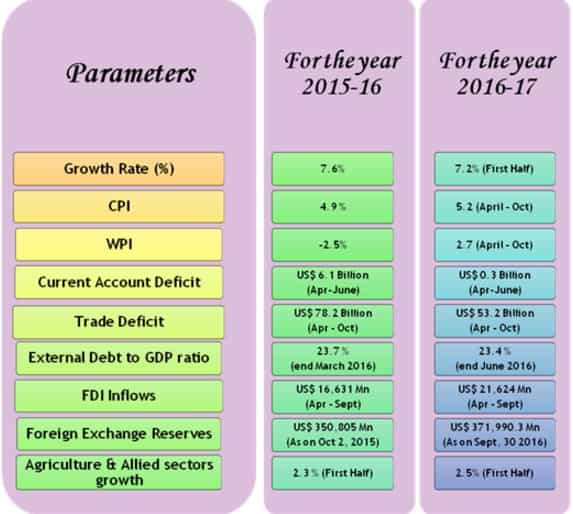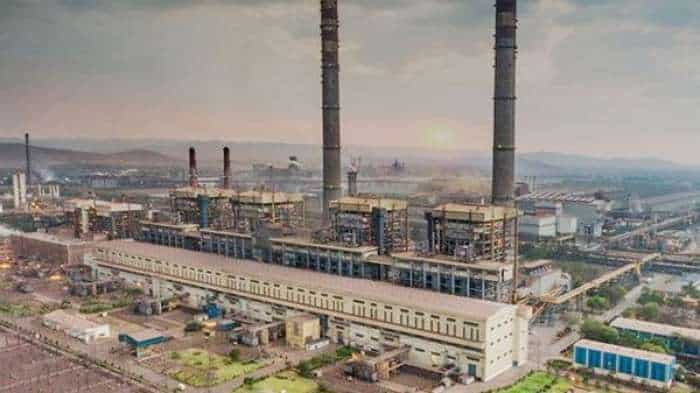Indian economy on track, government proves how

WPI inflation declined to (-) 2.5% in 2015-16 from 2% in 2014-15.
As the year coming to an end, Ministry of Finance on Friday released a data showing how economic growth in India continued to be robust despite global sluggishness.
As per the Ministry, the growth rate of the economy during the H1FY17 was estimated at 7.2%. At the sectoral level, the growth rates for agriculture & allied sectors, industry and services sectors for the same period, were estimated at 2.5%, 5.6%, and 9.2% respectively.
"The stress given to fiscal consolidation through expenditure rationalization and revenue raising efforts and the focus on administrative measures for cooperative financial governance and also steps towards containing inflation have contributed significantly to macro-economic stability," the Ministry said.

Inflation
Inflation measured in terms of Consumer Price Index and Wholesale Price Index has remained in comfort zone during the current FY17.
CPI (Combined) inflation for 2015-16 declined to 4.9% from 5.9% in 2014-15. It averaged 5.2% in 2016-17 (April-October) and stood at 4.2% in October 2016.
Food inflation as measured by Consumer Food Price Index (CFPI) declined to 4.9% in 2015-16 from 6.4% in 2014-15. It averaged 6.1% in 2016-17 (April-October) and eased to 3.3% in October 2016.
WPI inflation declined to (-) 2.5% in 2015-16 from 2% in 2014-15. It averaged 2.7% in 2016-17 (April-October) and stood at 3.4% in October 2016.
TRADE
India’s merchandise exports (customs basis) declined by 15.5% to $262.3 billion in 2015-16. In 2016-17 (April-October), growth of exports declined by 0.2% ($154.9 billion vis-à-vis $155.2 billion in the corresponding period of previous year).
Imports declined by 15% to $381 billion in 2015-16. Imports for 2016-17 (April-October) were at $ 208.1 billion which is lower by 10.9% as compared to $233.4 billion in the corresponding period of previous year.
During 2016-17 (April-October), trade deficit decreased to $53.2 billion as against $78.2 billion in the corresponding period of previous year.
"There has been significant market diversification in India’s trade from Europe and America to Asia and Africa in recent years –a process that has helped in coping up with the sluggish global demand," Ministry said.
Balance of Payments
Current Account Deficit (CAD) narrowed down to $ 2.2 billion (1.1% of GDP) in 2015-16 as compared to $26.9 billion in 2014-15. CAD narrowed down to $0.3 billion (0.1% of GDP) in 2016-17 (April-June) from $6.1 billion (1.2% of GDP) in corresponding period of the previous year.
Foreign Exchange Reserves
In the current fiscal 2016-17, foreign exchange reserves culminated to $372.0 billion at end September 2016 which reduced to $366.2 billion at end October 2016. Foreign exchange reserves stood at $365.3 billion on November 25, 2016, showing an increase of $5.1 billion over the level of $360.2 billion at end-March 2016.
External Debt
India’s external debt stock stood at $479.7 billion at end-June 2016, witnessing a decline of $5.4 billion (1.1%) over the level at end-March 2016. The external debt-GDP ratio was 23.4% at end-June 2016, as against 23.7% at end March 2016.
The share of long-term external debt in total external debt increased marginally to 82.9% at end-June 2016 from 82.8% at end-March 2016.
Agriculture and Food Management
Agriculture and allied sectors registered a growth of 2.5% during the H1FY17 as compared to 2.3% during the same period in 2015-16. As per the First Advance estimates (1st AE) 2016-17 released by Department of Economics and Statistics, production of Kharif food grains is estimated to increase to 135.03 million tonnes as compared to 124.01 million tonnes in 2015-16 (AE).
Industry
The data on Index of Industrial Production (IIP) released by the Central Statistical Office (CSO) shows that the production of industrial sector broadly comprising mining, manufacturing and electricity sectors has fallen by 0.3% during April-October (2016-17) as compared to 4.8% growth during April-October (2015-16).
Get Latest Business News, Stock Market Updates and Videos; Check your tax outgo through Income Tax Calculator and save money through our Personal Finance coverage. Check Business Breaking News Live on Zee Business Twitter and Facebook. Subscribe on YouTube.



